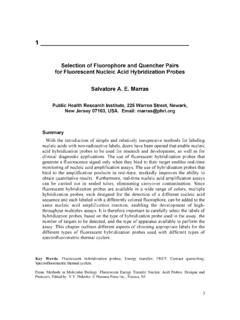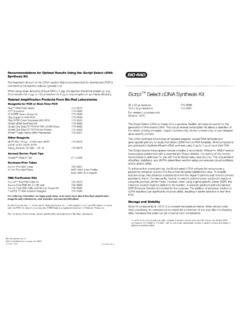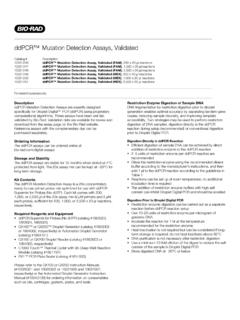Transcription of Pitfalls in qPCR - BioScience Events
1 Pitfalls in qPCRP rimer and probe design and synthesisMary SpanEurogentec in qpcr assay Set up experiment statistical relevant # samples/experimental group controls Design and synthesis primers and probes RNA extraction quality of RNA Reverse Transcription reaction one step or two step reaction qpcr reaction singleplex or multiplex Data analysis3 PCR efficiency High PCR efficiency high accuracy high reproducibility PCR efficiency influenced by length of amplicon GC content of amplicon secondary structures in primers, probes , amplicons concentration reaction components PCR inhibitors/PCR enhancers quality RNA/cDNA4 PCR efficiency Easiest way to determine PCR efficiency.
2 Standard curve with R2 close to 1,00 and intercept close to -3,32 Exponential amplification = 10(-1/slope)Efficiency = 10(-1/slope) -15 PCR efficiency 100% PCR efficiency every PCR cycle amount of DNA is doubled 2x dilution curve Ct of 1 between every dilution 10x dilution curve Ct of 3,2 between every dilution Variation coefficient (R2) indication how well data points lie on one straight line low R2 indication for pipetting mistakes, inaccurate way of working, diluting out inhibitory factors6 Why do you need a good design?
3 Well-designed primers and probes are a prerequisite for successful RT qpcr in terms of high PCR efficiencies specific PCR products no co-amplification of genomic DNA no amplification of pseudogenes most sensitive results7 Design makes the difference! Comparison between two different primer -probe sets for 18S rRNA using same reaction components and experimental conditions121 bp amplicon190 bp amplicon8 Design guidelines for primers Primers length 18-30 bases GC content 30-80% (ideally 40-60%) Tm 63-67 C (ideally 64 C), so that Tannealing is 58-62 C (ideally 59 C)
4 Tm forward primer and reverse primer < 4 C avoid mismatches between primers and target, especially towards the 3 end of the primer avoid runs of identical nucleotides, especially of 3 or more Gs or Cs at the 3 end avoid 3 end T (allows mismatching) avoid complementarity within the primers to avoid hairpins (check using a software) avoid complementarity between the primers, especially at 2 or more bases at the 3 ends of the primers to avoid primer -dimers (check using a software) design intron spanning or flanking primers to avoid co-amplification of genomic DNA (only possible in multiple exon genes, in single exon genes perform DNase I treatment of samples with RNase free DNase (Vandesompele, 2002))# Positions of exons and introns can be found in NCBI LocusLink databases ( )
5 9 Intron spanning/flanking primers Intron spanning primersForwardReverseReverseForwardExon 1 Exon 3 Exon 2 Exon 1 Exon 2 Exon 3No amplificationgDNAA mplificationcDNA10 Intron spanning/flanking primers Intron flanking primersForwardReverseReverseForwardExon 1 Exon 3 Exon 2 Exon 1 Exon 2 Exon 3 Large amplicon*gDNAS mall amplicon*cDNA* Can be detected via melt curve11 Design guidelines for probes 5 Exonuclease probes length 18-30 bases (>30 bases required, use internal quencher on dT around 20th base) Optimal: 20 lengths over 30 bases are possible, but it is recommended to position the quencher not at the 3 end, but internally 18-25 bases from the 5 end GC content 30-80% Tm Tm of the probe must be 8-10 C higher than the Tm of the primers (8 C for genotyping, 10 C for expression profiling)
6 Select the strand that gives the probe more Cs than Gs place probe as close as possible to primers without overlapping them avoid mismatched between probe and target avoid runs of identical nucleotides, especially of 4 or more Gs avoid 5 end G (quenches the fluorophore) avoid complementarity of the probe with either of the primers (check using a software) for multiplex assays: for genotyping position the polymorphism in the center of the probe adjust the probe length so that both probes have the same Tm12 Design guidelines for amplicons Amplicon length for SYBR green I assays: 80-150 bp shorter amplicons will give higher PCR efficiencies longer amplicons will give a higher Rn as more SYBR green I is incorporated length for 5 exonuclease probe assays.
7 80-120 bp shorter amplicons will give higher PCR efficiencies shorter amplicons will give more efficient 5 nuclease reactions GC content 30-80% (ideally 40-60%) avoid secundary structures in the amplicon (check with Mfold: ) check if generate amplicon is unique by submitting primers (and probe) to a BLAST search ( )13 Frequent Pitfalls I do already have existing primers of a normal PCR, but can not find a good probe to fit them. What should I do? Although it is disappointing to hear, it is best to do the design from scratch.
8 The criteria for primers are less stringent as for probes . I have used a design software to design my primers and probes , but it do not get them to work properly A design software is not a 100% guarantee to get a good primer /probe set, but is a good tool to make your life easier Especially with SYBR green I assays; try several primer sets as in silico differs from experimental14 Frequent Pitfalls The design software that I use can not find a suggestion, although the sequence if have inserted is more than 500 bases long It is not always possible to design a primer /probe set for a specific sequence due to GC/AT rich sequences, repeats or secundary structures) In most cases you can already see the most homogenous part of your sequence by eye.
9 This is the best part to design your primers and probe on Sometimes you can force the software to design a primer -probe set by changing the parameters like ampilicon length, primer length, Tm s or GC content15 Frequent Pitfalls I took the first suggestion in the list of primer Express , but the primer /probe set does not lead to good results The first suggestion in the list of primer Express is the shortest amplicon, not the best primer /probe set With the recommended temperature profile I obtain an amplicon, but the detection does not function due to the probe, which is not binding Each software uses its own method of calculating the Tm and there can be a difference between the calculated and experimental temperature If the probe does not bind to the amplicon then the annealing temperature is too high in comparison to the Tm of the probe Check Tm using several softwares.
10 If Tm s differ > 3 C check Tm experimentally16 Predicted vs. experimental TmSource: ABI User Bulletin 6 ABI PRISM Sequence Detection System17 Probe too long or Tm too low?Conformation change from B helix to A helix due to LNAs AT rich sequence: long probes required to reach correct Tm SNP detection: short probes required to increase specificity With LNA bases length probes can be decreased or Tm can be increased18 Example probe assay Jump in dilution series caused by secondary structure in primer19 Example SYBR green I assay Ct s of all dilutions around same point due to primer dimers20 Choice of fluorophore and quencher is part of a good design Well-chosen fluorophores and quenchers are a prerequisite for successful RT qpcr in terms of maximal fluorescence minimal back ground maximal signal-to-noise ration maximal







